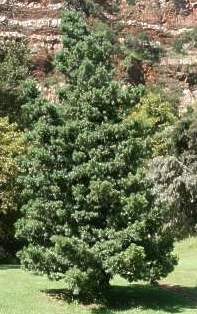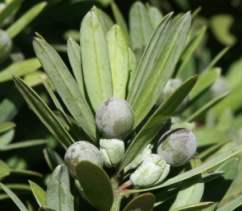Podocarpus latifolius
Podocarpus latifolius (Thunb.) R.Br. ex Mirb.
Family: Podocarpaceae
Common names: real yellowwood ( Eng. ); opregte geelhout (Afr.); umkhomba (Xhosa); mogobagoba (Northern Sotho); muhovho-hovho ( Venda ); umsonti (Zulu)
SA Tree No: 18
Introduction
The real yellowwood is one of South Africa 's most valued timber trees. It is also South Africa 's National Tree.

Description
Description
Podocarpus latifolius is a slow-growing, usually large, evergreen tree, which grows to between 20 and 30 m in height. Under some conditions, the tree does not grow more than about 2 m but looks very old and full of character.
The wood is yellow and quite similar to P. falcatus, the Outeniqua yellowwood, although not as dark or of the same quality. The bark is greyish and smooth when young but shows the characteristic longitudinal fissures as it matures. The bark peels off in strips.
The glossy green leaves are long and narrow. The leaves on young trees are always larger than on mature trees. The new leaves are very noticeable as they form clusters of pale green or bronze at the ends of branches, compared to the dark green of the older leaves.
There are male and female trees. The male cones (July to September) resemble catkins (an inflorescence adapted for wind pollination, found on the exotic Betula species, for example) while the female tree develops round, grey/blue seeds on thickened, fleshy, stalks known as receptacles, which as they mature, turn purple (December to February).

Conservation Status
Status
All the species of Podocarpus are protected in South Africa. In the past, they were so sought after as timber trees, that from being an abundant resource they became almost extinct in some areas. Yellowwood furniture commands high prices today because of its rarity.
Distribution and habitat
Distribution description
The real yellowwood grows naturally in mountainous areas and forests in the southern, eastern and northern parts of South Africa, extending into Zimbabwe and further north. It is also found on rocky hillsides and mountain slopes but does not get as tall where it is exposed as it does in the forests.
Derivation of name and historical aspects
History
The genus and species names are derived from Greek words, podo which means foot, carpus which means fruit, lati which means wide and folius which means leaf. Podocarpaceae is a small cone-bearing family, which, along with the indigenous cedars, represent the small number of coniferous tree species indigenous to South Africa.
Ecology
Ecology
When the berry-like receptacles ripen, birds such as pigeons and turacos feed on them. They are also eaten by monkeys, bushpigs and sometimes by people.
Uses
Use
The real yellowwood has apparently been used more than any other South African timber. Floors in the old Cape homesteads were made of this wood. The soft yellow colour of the wood contrasts beautifully with the dark-coloured stinkwood (Ocotea bullata ) and these two timbers were often used together to make furniture. The real yellowwood was used a lot for tables and cupboards, as it polishes up very well. The South African Railways used to use the timber to make railway sleepers. In the old days it was used to make wagon boxes. Coffins were often made of it too. An unusual use was that of a butcher's block because the wood is hard and did not chip easily. It also has no scent, so it did not taint the meat.
The real yellowwood is slow-growing, but very long-lived and it is able to withstand some frost. The unusual textural appearance of the leaves makes it a good contrast or background for other trees. The colourful receptacles of the female tree are most attractive. This tree would make an interesting container plant and can withstand short periods indoors. The leaf size and interesting bark are good characteristics for bonsai.
Growing Podocarpus latifolius
Grow
Seed should be cleaned and sown fresh in a mix of sand and compost. Do not allow it to dry out or germination will be poor. The seed may be parasitized if collected from the ground below the tree. Transplant with care and avoid damaging the taproot. The expected growth rate in cultivation is quite slow, but this depends on conditions. It will grow better with good soil, water and shelter from strong winds. It does not usually grow as tall in cultivation as it would in its forest habitat, especially if not given a good water supply.
There are three other yellowood species in South Africa, all of which may be grown in the garden.
References
- Blackmore, S. (ed.). 1984. The Penguin dictionary of botany . Penguin , England.
- Coates Palgrave, K., Coates Palgrave, P. & Coates Palgrave, M. 1985. Everyone's guide to trees of South Africa . Struik, Cape Town.
- Coates Palgrave, M. 2002. Keith Coates Palgrave Trees of southern Africa, edn 3 . Struik, Cape Town.
- Esterhuyse, N. 2001. Remarkable trees of southern Africa . Briza Publications, Pretoria.
- Grant, R. & Thomas, V. 1998. Sappi tree spotting: Highveld and the Drakensburg . Jacana, Johannesburg .
- Johnson, D.& Johnson, S. 1993. Gardening with indigenous trees and shrubs . Southern Books, Cape Town .
- Palmer,E. & Pitman, N. 1972. Trees of southern Africa . Balkema, Cape Town.
- Venter, F. & Venter, J-A. 1996. Making the most of indigenous trees. Briza Publications, Pretoria .
Credits
Patrick Mtsweni with additions by Andrew Hankey and Alice Aubrey
Walter Sisulu National Botanical Garden
October 2005
Plant Attributes:
Plant Type: Tree
SA Distribution: Eastern Cape, Free State, KwaZulu-Natal, Limpopo, Mpumalanga, Western Cape
Soil type: Sandy, Loam
Flowering season:
PH: Acid, Neutral
Flower colour:
Aspect: Morning Sun (Semi Shade)
Gardening skill: Easy
Special Features:
Horticultural zones











Rate this article
Article well written and informative
Rate this plant
Is this an interesting plant?
Login to add your Comment
Back to topNot registered yet? Click here to register.